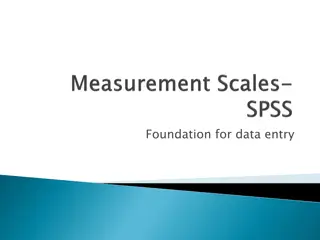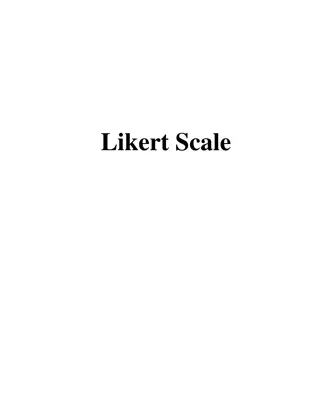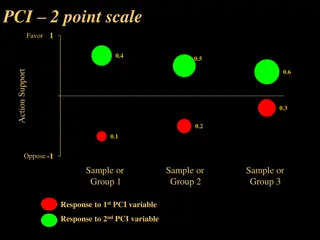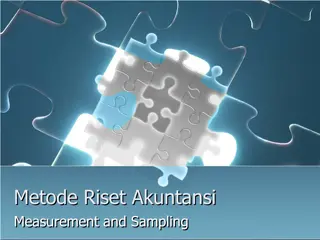Measurement Scales
Variables play a crucial role in research studies as they represent characteristics with values across different groups. Understanding measurement scales, including nominal, ordinal, and interval, aids researchers in assigning attributes and ordering variables effectively. Each scale offers unique features for data analysis, from simple categorization to meaningful distance measurements. By utilizing these scales, researchers can derive valuable insights and enhance the quality of quantitative research methodology.
Download Presentation

Please find below an Image/Link to download the presentation.
The content on the website is provided AS IS for your information and personal use only. It may not be sold, licensed, or shared on other websites without obtaining consent from the author.If you encounter any issues during the download, it is possible that the publisher has removed the file from their server.
You are allowed to download the files provided on this website for personal or commercial use, subject to the condition that they are used lawfully. All files are the property of their respective owners.
The content on the website is provided AS IS for your information and personal use only. It may not be sold, licensed, or shared on other websites without obtaining consent from the author.
E N D
Presentation Transcript
Measurement Scales Dr. Sarita Anand Assistant Professor Department of Education Vinaya Bhavana (Institute of Education) Visva-Bharati, Santiniketan sarita.anand@visva-bharati.ac.in 1
MEASUREMENT SCALES A Scale is a tool or mechanism by which distinguished as to how they differ from one another on the variables of interest to our study. individuals are In statistics and quantitative research methodology, levels of measurement are developed by the psychologist Stanley Smith Stevens. Stevens (1946) classified variables into four levels. These are referred to as level of measurement. 2
What are Variables and Measurements Variables: Characteristics that can take on values for different members of a group. For example height different Measurements: Assignment of numbers to Characteristics (variables) of objects, persons or events. 3
SCALES Levels Nominal Scale Ordinal Scale Attributes can be ordered Interval Scale Distance is meaningful Ratio Scale Attributes are only named; weakest Absolute zero 4
NOMINAL SCALE A nominal scale is one that allows the researcher to assign subjects to certain categories or groups. Assignment of numbers to the categories has no mathematical meaning like Example: Country of Origin 3 = Canada 4 = Other 1 = United States 2 = Mexico However, in this case, it is important to keep in mind that the numbers do not have intrinsic meaning 5
ORDINAL SCALE An ordinal scale categorizes the variables in such a way as to denote differences among the various categories, it also rank-orders the categories in some meaningful way. For example: APPs RANKING Whatsapp Telegram Hike Line Wechat Common example of ordinal scale include quality ranking, socioeconomics classes, and occupational status. 6
INTERVAL SCALE An interval scale allows to perform certain operations on the data collected from the respondents. Interval comparisons of the differences of magnitude (e.g. of attitudes) but do not allow determinations of the actual strength magnitude. scales allow arithmetical of the Zero point on the interval scale is arbitrary zero, it means the complete absence of anything Interval scales indicate order and also the distance in the order. does not Temperature Scale in Fahrenheit. For example: Strongly Disagree Disagree Neither agree nor Disagree Agree Strongly Agree My job offers me a chance to test myself and my abilities 7
Interval scales allow comparisons of the differences of magnitude (e.g. of attitudes) but do not allow determinations of the actual strength of the magnitude. 8
RATIO SCALES This scale has a unique or fixed beginning or true zero point. (complete absence of the phenomenon being measured) Ratio scale allow comparisons of the differences of magnitude (e.g. of attitudes) as well as determinations of the actual strength of the magnitude. For example:Boys 20 and Girls 30 Then the ratio will be 1:1.5 This scale has a unique or beginning or (complete absence phenomenon being measured) fixed point. the Weight (in grams) is variable. Again, the zero value meaningful, zero grams means the absence of weight. also a ratio true zero is of 9
Dichotomous scale to elicit yes or no answer For example: Do you own a car? o Yes o No Category scale for multiple items to elicit a single response For example: your caste o Gen o OBC o SC o ST oOthers 10
Semantic differential scale several bipolar attributes are identified respondents are asked to indicate their attitudes Honest Dishonest For example:Courageous Timid Numerical scale The scale provides number on a five-pointorseven point with bipolaradjectives at the end For example: Honest [7 6 1] Dishonest 5 4 3 2 11
Stapel scale it measures both the direction and intensity of the attitude For example: state how you would rate your supervisor s abilities with respect to each of the characteristics mentioned below +3 +2 +1 product innovation -1 -2 -3 +3 +2 +1 interpersonal skills -1 -2 -3 12
Graphic rating scale it is a graphical representation For example: on a scale of 1 to 10, how would you rate your supervisor? Adequate 5 very bad 1 2 3 4 6 7 8 9 10 excellent 13
Forced choice scale there will be two alternatives choice is to select one alone For example: which is your favorite subject? o maths o science 14























